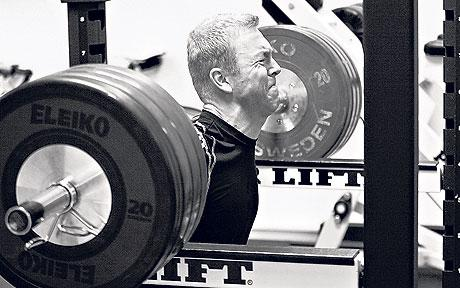(6) Weights make women bulky and manly
In the past and even to this day, this common falsehood has resulted in women evading weights due to their belief that they will make them bulky and manly. This is completely untrue. The truth of the matter is women do not produce enough testosterone in their bodies to emulate muscular structures that men can.

Is this woman bulky?
This notion of ‘becoming bulky’ has largely come about due to some women taking anabolic steroids (usually bodybuilders). Such individuals (for whatever reasons) purposely increase levels of testosterone in their bodies so they are able to develop a more muscular and bulkier physique. This can also lead to them developing perceived manly traits such a deeper voice etc.
Outside the steroid world, women can massively benefit from a properly prescribed strength training programme and what’s more, they won’t become bulky! Many benefits include their ability to function during everyday tasks and improved sporting performance. Perhaps the most significant advantage of strength training in the eyes of most women is the positive metabolic effect it can have on fatloss and body composition (see myth 5).

The effects of steroids
Actually while we’re on this subject, I’m able to put to rest another myth that exists, ‘toning’. This is simply a gimmick phrase for strength training. Can someone please tell me the difference? It’s merely ‘light strength training’ with high reps. In fact, people who train with high reps in the pursuit of a more ‘toned’ physique would actually benefit more from lower reps!
Again, this is another example of a fallacy in the commercial industry. Facts speak volumes, and facts are revealed through science and experience. The fact in this case remains; whatever the goals, women can massively benefit from resistance or strength training.
(7) Weights slow you down
I had a great discussion with Strength and Conditioning Coach Andy Tsang (Varsity Gym) regarding this topic. We both agreed that the ‘weights slow you down’ concept was one of, if not the most frustrating fallacy in athletic training!

Chris Hoy lifts weights, is he slow?
Andy kindly agreed to write his views on this matter. See below for his response. This myth regarding whether ‘weights slow you down’ is largely multifaceted and not as simple as merely stating weights slow you down. While part of the statement may hold true, it’s not lifting weights that cause you to slow down but it depends on HOW you get the body to react to a training stimulus.
First of all, speed is expressed in a number of ways such as starting strength, speed strength (speed at the aid of strength), strength speed (strength at the aid of speed), and speed endurance. So those who think or claim speed is expressed as only being fast, they are being far too vague.
Looking at it from a scientific view, speed is measured as distance divided by time. Two key factors that contribute to this are ‘Power’ and Force. Power is measured as Force x Distance/Time. The Rate of Force Production is determined by the speed of which muscles are excited and create tension through all types of movement (eccentric, concentric, isometric). You see, force moves mass and the greater the mass the slower the acceleration. However, the greater the force the greater the acceleration.
It’s simply a case of the more force an athlete has inside their muscles to move their joints the faster they will become. External training (i.e. weights) increases the amount of ‘force’ in your muscles. Therefore, does it not make sense that lifting weights will make you faster? Of course it does!
The issue regarding ‘slowing down’ is due to the equation of moving maximal weights (greater mass) and applying maximal force where movement will be slow. You see, the neuromuscular adaptation of the human body i.e. moving great mass with maximal force, will eventually make the body produce maximal force but at a slow rate.
This situation however is not a concern for most people as often is the case they are weak and this includes many top athletes. Therefore, even if someone only trains one part of the equation (i.e. developing force) they will still see gains in terms of speed. Again as mentioned previously, it’s not lifting weights that slow you down but HOW you get your body to react to a training stimulus.
In conclusion to this myth, it’s no wonder so many athletes are confused and tentative when incorporating weights in their programme. However, I STRONGLY believe a ‘properly prescribed programme’ that incorporates weights and other methods of improving speed where necessary (i.e. dynamic strength training) will be hugely advantageous to an athlete’s sporting performance. So get under the bar!
(8) Endless sit-ups will give you a 6 pack
Do you remember all those times you would sit in your bedroom and endlessly do situps or crunches in an attempt to develop that illustrious 6 pack? Well I’m sorry, but it was a complete waste of time! The only means of seeing your 6 pack (which is already there believe it or not) is by lowering your bodyfat.
Don’t get me wrong, training the abs via resistance training is beneficial as adaptations can be made both in terms of size and strength. However, no amount of abs specific training will show your hard work if your bodyfat is too high, it’s as simple as that.

'How To' Screw Your Back - excessive lumbar and cervical spinal flexion is a disaster waiting to happen
The next confusing question is how to properly train the abs. Who in their right mind decided that endless sit-ups and crunches are the best methods to do this? What makes training this group of muscles any different from the others? Endless reps will only manufacture minor gains such as muscular endurance and slight hypertrophy, if that.
So what’s the solution?
First of all, the abs should not be trained in isolation. This is impossible in any case (see myth 1) but there is a tendency for most people to solely focus on the rectus abdominis (most-well known abdominal muscle that forms the six-pack). This is a recipe for disaster as other abdominal muscles and particularly the lower back often become neglected. Instead it makes sense to train the whole ‘core’. For most people, the core consists of the abdominal and back muscles. On the other hand, many renowned strength coaches believe that core training should also include the posterior chain (glutes, hamstrings and lower back). For the purposes of this section however, we’ll assume the core consists of the abdominals and back muscles only.
Now to the science. The abdominal wall consists of 4 paired flat muscles that promote movement of the vertebral column. The rectus abdominis (trunk flexion, stabilisation of pelvis), external/internal obliques (lateral flexion, trunk rotation) and the tranverse abdominis (trunk stability, tightening of abdominal wall). The muscles of the back are arranged in 3 layers which include multifidus (stability, rotation, extension), the erector spinae (back extension), the lumbar spine (maintains upright posture) and the iliopsoas (hip flexion).
There are a lot more muscles involved in the abdominis and lower back but for now this list gives a good insight into the sheer number of muscles involved and the role they play in the functioning of the body.
From this list, it is clear to see why people are confused regarding exactly what the core is. They and the everyday trainer however don’t need to worry about this, you just need to train the core accordingly to its prime movements; extension, flexion, lateral flexion, stabilisation and rotation.
A good strength programme will work the core using exercises such as squats and deadlifts. However, key ‘core specific’ exercises that target all the prime movements may include russian twists, weighted sit-ups, hanging leg raises, roll-outs, back extensions, reverse hyperextensions, the flag (an absolute killer!), side bends, planks and hanging wipers etc.
Don’t neglect this area of training. The benefits are endless in terms of sporting performance, stability and performing everyday tasks. What’s more, you’ll have that carefully crafted 6-pack (that is if your bodyfat is low enough!)
(9) You should do static stretching before exercise
This is a particularly interesting one for me and perhaps the most undecided. So many coaches dispute whether static, dynamic, PNF or ballistic stretches etc should be done prior to exercise or after for that matter, but the whole debate is confusing and flawed for many reasons.
Firstly, very little research actually exists to support their own or any others views, which is why experience is perhaps the best measure in this instance. Secondly, many variables have to be considered such as the type of activity, the duration of the activity, the age of the training individual and the injury history of the training individual etc. As a result of this, it is difficult not to be general where stretching is concerned.
When discussing the static stretching myth, I will try to be as specific as I can regarding my views on the topic. In order for this to be possible I will discuss one ‘particular instance’ and methods I would adopt where stretching is concerned. This ‘particular instance’ will make reference to high intensity, relatively long duration, explosive team sports such as football, rugby or hockey etc. Below is my approach and other considerations.
(a) Like other methods of training, I believe it is important that every warm-up including stretching should be individually tailored to the athletes needs.
(b) In the beginning, a lot of coaches recommend athletes perform a ‘general’ warmup which increases the functional ability of the whole body before carrying out a ‘specific’ warm-up. A specific warm-up should stimulate the central nervous system and mimic the movements/skills necessary in whatever sport. I personally prefer that athletes only follow a ‘specific’ warm-up (with or without equipment).
The main reason I tend not to favour general warm-ups is because I believe the time it takes can be better spent during the specific warm-up. Don’t get me wrong, I believe general warm-ups can be useful particularly for athletes who may be recovering from injury or experiencing ‘tight’ muscles.
Nevertheless, for those not in these type of situations, energy expended can be better spent on sports specific matters. After all, the last thing an athlete wants to feel is tired or sluggish before a game.
(c) During the whole specific warm-up course, I would have athletes perform dynamic stretching throughout. The whole warming-up process should be developmental. Begin with slower movements and ranges of motion and work through until you are moving at explosive speed. Remember the whole point is to prepare for your sport and the demands it places on your body.
(d) At some stage during the specific warm-up, I would propose athletes perform a ‘static’ hip flexor stretch, a common problem area for athletes. This type of stretch specifically and intentionally lengthens the hip flexors and is a firm favourite of many renowned strength and conditioning coaches such as Joe Defranco. He suggests failure to lengthen the hip flexors alters the athlete’s mechanics resulting in negative effects on his/her strength and sporting performance.
(e) Additional ‘static’ stretches should be largely determined upon the individual athlete. It is much the trend these days that no static stretching should be done prior to performance as it inhibits or weakens working muscles. While this is true to some extent, coaches have to appreciate that some athletes will often be required to static stretch tight muscles. If these tight muscles aren’t statically stretched, this can also have a negative impact on the athletes working muscles and performance.
(f) Another matter that should be considered concerning static stretching is that of psychology. Put simply, some athletes feel ‘better’ if they perform some static stretching. In fact, one could argue that if static stretching makes a particular athlete feel better prepared, then this can have a positive effect on their performance.
The stretching situation or warm-up situation for that matter is largely confusing due to countless variables I mentioned earlier. Now while some coaches swear by static stretching and others don’t, I would recommend you approach the subject with an open mind. Individuals are different and as such respond in different ways. Prior to sporting performance, I personally prefer dynamic stretching with the exception of stretching the hip flexors and adductor groups but how you stretch of course is entirely up to you.
Regardless of the methods you prefer, just be conscious of the ‘main reason’ for doing it; to best prepare yourself for performance. What are the most effective method(s) in achieving this? Is there one? Who knows, but right now you’re probably not doing what’s best for you.
(10) All research is correct

Just how accurate is research?
I thought this would be a good one to end with. While it’s true we should all appreciate and pay attention to research, this doesn’t mean we should believe absolutely anything and everything it tells us. Far from it actually, as a lot of research is sometimes over-exaggerated and over-hyped. Why is this the case? There are many reasons, but one of the primary motives is due to commercial companies trying to promote their products and findings. These companies fund their own research therefore you can guarantee they will over-exaggerate their findings!
Another matter worthy of note is that most research tends to be conducted over a short period of time (weeks/months). Therefore can any real findings or discoveries be made during this time? It is well documented that major developments are usually made over a much longer period than this, surely research should reflect these circumstances?
An additional research matter is that concerning ‘research subjects’. The subjects tend to be overweight, unfit individuals of which most have probably only taken part in minimal exercise previous. If such a person suddenly enrols in a ‘research experiment’ consisting of a new training stimulus, of course they will make gains!
Don’t get me wrong, I’m not dismissing research altogether as many great findings/discoveries have been made. I would just question most fitness related matters. In fact, I would question all fitness related matters. Question coaches, question personal trainers, question teachers, question lecturers, question me, question this article, question everything. Just because someone says following programme A is better than following programme B doesn’t mean this is true. In fact, I bet anyone who has said this to you is completely wrong in any case.
Don’t walk blindly as often is the case these days. Read or study any supposed fitness facts you may have come across or better yet why not try ideas and experience matters for yourself. There’s nothing wrong with trial and error, that’s how we learn.
In fact, why are you still reading this article? Go, try something new, hit the gym, get a new personal best (PB), do whatever. Just try to stay clear and not be fooled by the fallacies that inevitably the fitness industry will continue to manufacture.










